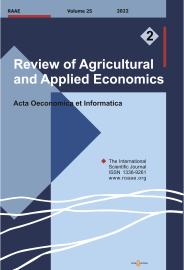KEYWORDS:
Income Patterns, Tomatoes, Quintile analysis, Diversification, Ghana
DOI NUMBER:
10.15414/raae.2018.21.02.58-70
ABSTRACT:
The study investigated the determinants of income patterns of tomato farmers by means of three income models based on the livelihood approach of linking income and income generating activities. Data for the study was collected from 562 randomly selected tomato farmers from six districts in three regions of Ghana. By employing OLS estimation, the study sought to identify the determinants underlying the respondents’ income pattern. The results of the study indicate that gender, wealth, number of years of education experience, number of years of experience in tomato production and farm size were the major socio-economic variables that significantly influenced one’s level of income. All the three income models indicate negative but significant relationship between income and the contributions made by secondary earners implying that social and family ties serve as a disincentive to increasing income levels as people take undue advantage of it. Moreover, all three income models study indicate negative but significant relationship between income and household size, an indication that increasing household size has negative consequences on income. The policy implication of this is that as part of agricultural extension activities, education on population issues and its implications for development be passed on to farmers.
Please Cite this Article as:
Daniel AIDOO-MENSAH (2018) Determinants Of Income Patterns Of Tomato Farmers In Ghana. Review of Agricultural and Applied Economics. XXI (Number 2, 2018): 58-70. doi: 10.15414/raae.2018.21.02.58-70
URL for sharing:
https://roaae.org/1336-9261/doi/abs/10.15414/raae.2018.21.02.58-70
FULL TEXT PDF:
▼ direct download link| view online in fullscreen ▲
References:
▼ direct download link

